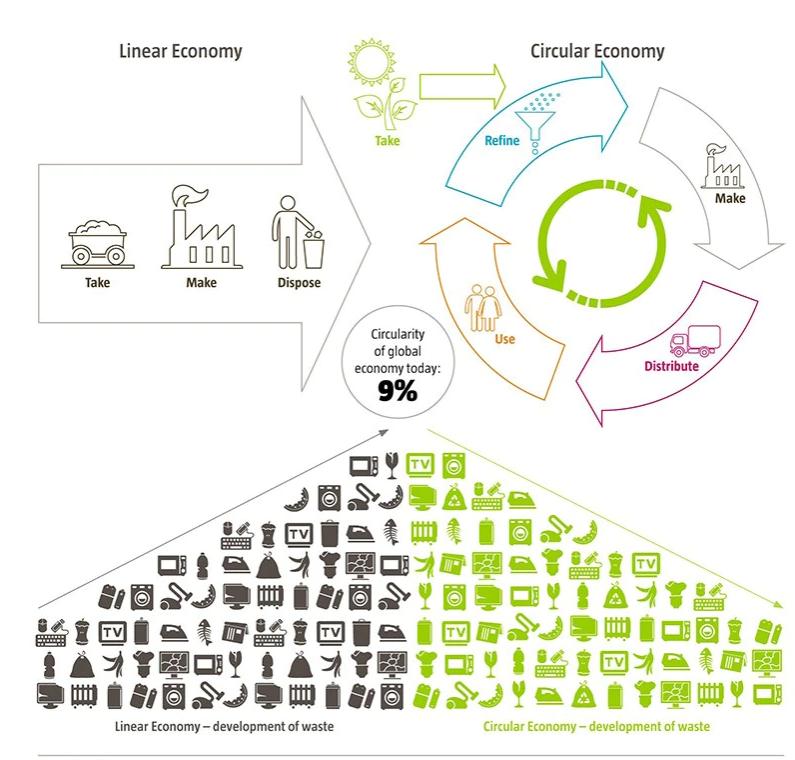The circular economy at a tipping point
The traditional linear economy based on the “take-make-dispose” production and consumption model has pushed the planet’s capacity out of balance, and has led to a growing coalition of scientists, innovators, policy-makers, and consumers calling for a transition to closed-loop production and consumption systems that minimize waste and emissions as well as material and energy losses. The switch to the circular economy could unlock an estimated USD 4.5 trillion of value globally by 2030, with innovative technologies providing new ways to create service models and to extract value from closed-loop systems.
“
The switch to the circular economy could unlock an estimated USD 4.5 trillion of value globally by 2030

Source: Robeco
Technological drivers of the circular economy
Technology is becoming a key enabler of the transition to a circular economy. Advances in artificial intelligence (AI), digital platforms and cloud-based solutions have greatly eliminated the need for physical assets, helping to de-materialize entire value chains. The ongoing digital penetration of production and logistics improves the traceability of resource and product flows and can help optimize product use over their lifetime, including predictive maintenance solutions. Increased visibility enables not only better control over potential waste creation, but also creates more accountability for companies along the value chain. Meanwhile, the advancement of new chemicals and catalysts enables production of bio-based materials to replace fossil alternatives.
Circular economy
Investing in the circular economy
We have identified four investment clusters that are set to benefit from the transition to the circular economy: the redesign of production inputs, enabling technologies, circular use, and loop resources.
The first cluster – ‘redesign inputs’ – captures investment opportunities that exploit the shift from fossil-based inputs to renewable ones. The ‘enabling technologies’ cluster focuses on solutions that either provide the infrastructure for circular economy businesses, contribute to the de-materialization of production or create new, non-linear business models such as product-as-a-service. The ‘circular use’ cluster includes companies that support circular consumption patterns through sustainable sourcing, sharing economy, product longevity, and reusability. The ‘loop resources’ clusters focuses on providers of solutions that extend product lifecycles or recover embedded value from disposed products.

Source: Robeco
Conclusion
The time looks ripe for directing the global economy toward higher circularity. Governments are standing firm behind their commitments to the circular economy despite the economic challenges due to the ongoing pandemic. By exposing critical vulnerabilities in global supply chains, the current pandemic has even lent additional urgency to the shift from linear to system thinking, while providing a glimpse into the extensive de-materialization possibilities ahead, empowered by maturing digitization solutions across several sectors.
As innovative technologies are helping to unlock new value from the circular economy, the shift to higher circularity is becoming a matter of basic economics rather than a trend driven purely by environmental urgency. Companies pursuing circular business models are set to win from the structural changes ahead, with innovation leaders applying circular economy principles to differentiate their product offering. Forward-looking investors can benefit from this as yet largely untapped growth story by allocating capital to business models aligned with circular economy principles or to the enablers of this transition.
Important information
The contents of this document have not been reviewed by the Securities and Futures Commission ("SFC") in Hong Kong. If you are in any doubt about any of the contents of this document, you should obtain independent professional advice. This document has been distributed by Robeco Hong Kong Limited (‘Robeco’). Robeco is regulated by the SFC in Hong Kong. This document has been prepared on a confidential basis solely for the recipient and is for information purposes only. Any reproduction or distribution of this documentation, in whole or in part, or the disclosure of its contents, without the prior written consent of Robeco, is prohibited. By accepting this documentation, the recipient agrees to the foregoing This document is intended to provide the reader with information on Robeco’s specific capabilities, but does not constitute a recommendation to buy or sell certain securities or investment products. Investment decisions should only be based on the relevant prospectus and on thorough financial, fiscal and legal advice. Please refer to the relevant offering documents for details including the risk factors before making any investment decisions. The contents of this document are based upon sources of information believed to be reliable. This document is not intended for distribution to or use by any person or entity in any jurisdiction or country where such distribution or use would be contrary to local law or regulation. Investment Involves risks. Historical returns are provided for illustrative purposes only and do not necessarily reflect Robeco’s expectations for the future. The value of your investments may fluctuate. Past performance is no indication of current or future performance.




















